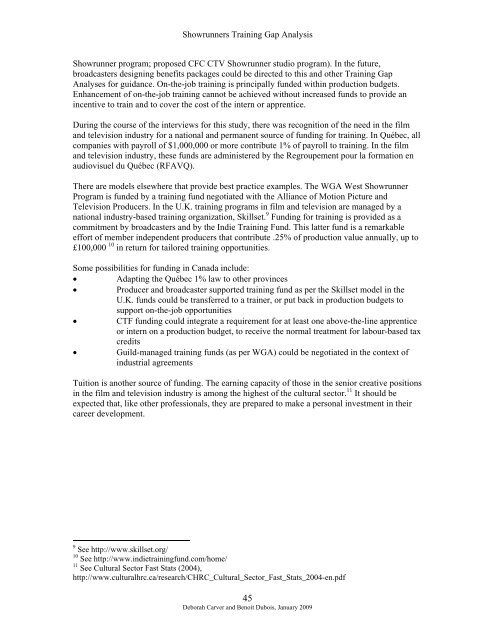Showrunners - Training Gaps Analysis - Cultural Human Resources ...
Showrunners - Training Gaps Analysis - Cultural Human Resources ...
Showrunners - Training Gaps Analysis - Cultural Human Resources ...
Create successful ePaper yourself
Turn your PDF publications into a flip-book with our unique Google optimized e-Paper software.
<strong>Showrunners</strong> <strong>Training</strong> Gap <strong>Analysis</strong><br />
Showrunner program; proposed CFC CTV Showrunner studio program). In the future,<br />
broadcasters designing benefits packages could be directed to this and other <strong>Training</strong> Gap<br />
Analyses for guidance. On-the-job training is principally funded within production budgets.<br />
Enhancement of on-the-job training cannot be achieved without increased funds to provide an<br />
incentive to train and to cover the cost of the intern or apprentice.<br />
During the course of the interviews for this study, there was recognition of the need in the film<br />
and television industry for a national and permanent source of funding for training. In Québec, all<br />
companies with payroll of $1,000,000 or more contribute 1% of payroll to training. In the film<br />
and television industry, these funds are administered by the Regroupement pour la formation en<br />
audiovisuel du Québec (RFAVQ).<br />
There are models elsewhere that provide best practice examples. The WGA West Showrunner<br />
Program is funded by a training fund negotiated with the Alliance of Motion Picture and<br />
Television Producers. In the U.K. training programs in film and television are managed by a<br />
national industry-based training organization, Skillset. 9 Funding for training is provided as a<br />
commitment by broadcasters and by the Indie <strong>Training</strong> Fund. This latter fund is a remarkable<br />
effort of member independent producers that contribute .25% of production value annually, up to<br />
£100,000 10 in return for tailored training opportunities.<br />
Some possibilities for funding in Canada include:<br />
• Adapting the Québec 1% law to other provinces<br />
• Producer and broadcaster supported training fund as per the Skillset model in the<br />
U.K. funds could be transferred to a trainer, or put back in production budgets to<br />
support on-the-job opportunities<br />
• CTF funding could integrate a requirement for at least one above-the-line apprentice<br />
or intern on a production budget, to receive the normal treatment for labour-based tax<br />
credits<br />
• Guild-managed training funds (as per WGA) could be negotiated in the context of<br />
industrial agreements<br />
Tuition is another source of funding. The earning capacity of those in the senior creative positions<br />
in the film and television industry is among the highest of the cultural sector. 11 It should be<br />
expected that, like other professionals, they are prepared to make a personal investment in their<br />
career development.<br />
9 See http://www.skillset.org/<br />
10 See http://www.indietrainingfund.com/home/<br />
11 See <strong>Cultural</strong> Sector Fast Stats (2004),<br />
http://www.culturalhrc.ca/research/CHRC_<strong>Cultural</strong>_Sector_Fast_Stats_2004-en.pdf<br />
45<br />
Deborah Carver and Benoit Dubois, January 2009










